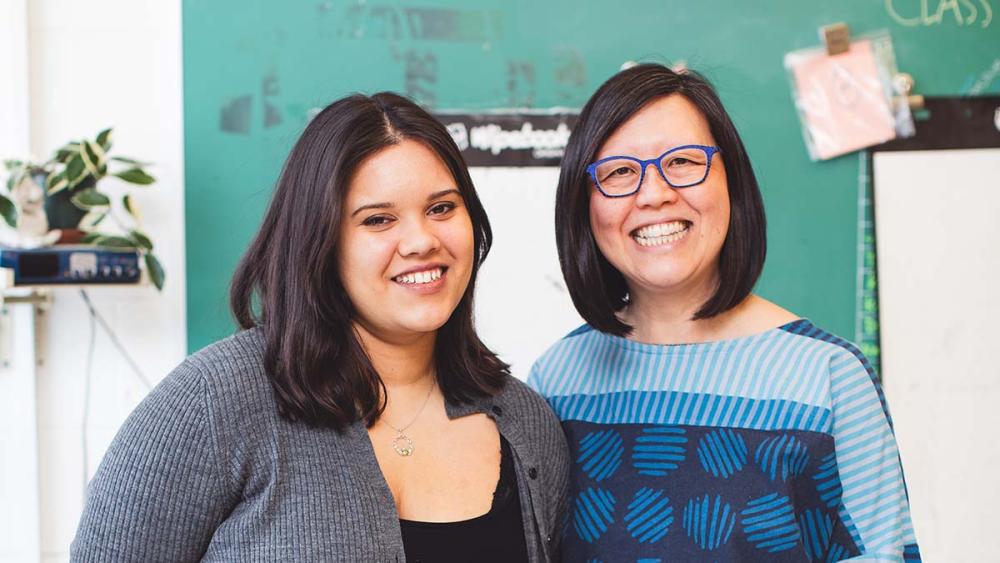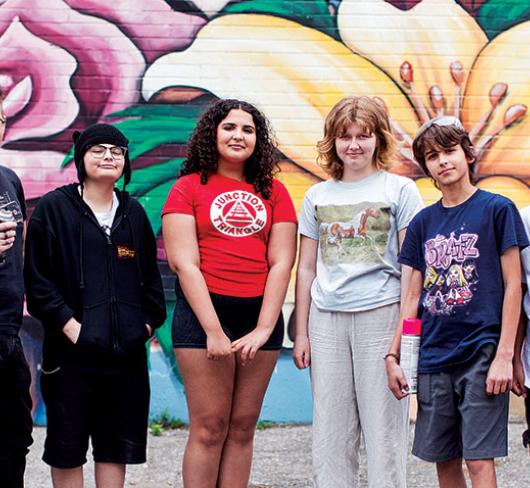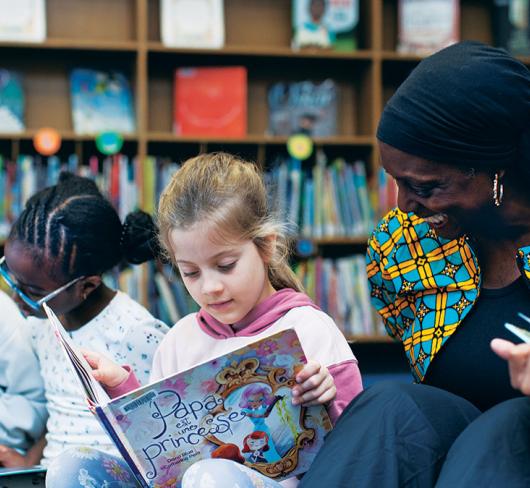
Students Becoming Changemakers
Cecilia La Rose-Luciuk is one of 15 young people, aged 10 to 19, who filed a lawsuit in 2019 stating that the federal government of Canada is contributing to harms caused by climate change. At the time, Cecilia was 15 years old. The case, La Rose v. His Majesty the King, argues that the government is violating the youths’ rights to life, liberty and security under Section 7 of the Canadian Charter of Rights and Freedoms. The young plaintiffs also allege that they are disproportionately affected by the effects of climate change and that the government’s actions violate their rights under Section 15 of the Charter. The group is demanding the federal government develop and implement a climate recovery plan to protect the rights of youth and the case is set for an eight-week trial in October 2026, in Vancouver.
Cecilia is a former student of Emily Chan’s, and the conversation that follows was prompted by their mutual interest in reflecting on the value of education, identity and community in climate justice activism.
Emily Chan: Thinking of seeds as symbols of inspiration, what are some seeds planted in your life that motivated you to become an activist?
Cecilia La Rose-Luciuk: Community is synonymous with activism for me. It’s a part of my life and a reflection of the people around me more than anything. In elementary school, the process of finding my identity as an individual, facing some challenges and also seeing myself as a part of my school community sowed the seeds for my work.
I’ve always felt confident in my culture and identity as a mixed-race person from an immigrant family. My father is Arawak, Indigenous from Guyana, and none of that felt complicated to me until I went to school and met people who were different from me in all of those ways. That’s where my own activism started, seeing what other people had to say about my identity.
Identity is something we build in collaboration with the people around us. In Canada, the word Indigenous is relevant to how we discuss politics and activism on a larger scale. My understanding of my own identity and awareness of this context is important to how I approach activism. Nothing that I say or do is the product of my opinions, more so the product of who I am.
EC: You weave together important connections about identity, community and standing up for what we believe in. How does climate change or climate justice fit into your work?
CL-L: I learned about climate change both at school and at home early on. It was the merging of the two that really instigated my strong feelings about how we approach climate change and what we do about it. At school, I was getting a science-based education. At home, I learned from my grandfather about climate change and what it means for our family in Guyana and for people from our reserve.
My family left Guyana in large part because of the damage done by Canadian mining companies. I remember thinking at a young age that it’s ironic that I’m here now and my family had to pick up everything and come to Canada since Canadian companies were responsible for the disappearing resources on my family’s land.
When I started my work, I felt really profound anger over the injustices of climate change. Now, I view my activism less as stemming from anger and more as a desire to build community. I think we forget that children bring a lot of themselves to school and lessons in class can land very differently depending on their identities and personal experiences.
EC: You’re one of 15 young people who filed a lawsuit against the Canadian government for violating the Charter of Rights and Freedoms by contributing to harms done by climate change. When did you join the lawsuit and how did that come about?
CL-L: In late 2018, I was involved in organizing climate strikes. It was the first time I was involved in primarily youth-based protests, where young people were voicing their opinions and making decisions. At the time, there were a lot of conversations among adults about climate change from a policy perspective, like COP20. Among young people, there was a lot of frustration, anger and despair because it felt like the mainstream conversation about climate change was not fully addressing the urgency that young people were feeling.
I remember having really cold winters and I remember snowball fights. Since my childhood, things had changed faster than I could make sense of. It was commonly understood among my peers that over the course of our lives we would have to deal with a lot of uncertainty in regard to the environment. At the time the lawsuit felt like one of the few options I had.
I was 14 when we began the process of preparing to file. Initially when I spoke to my father about the lawsuit, his response was to tell me about the work my aunt had done before I was born. That, in the wake of one of the world’s largest mining disasters that saw 80 kilometres of the Essequibo River declared an environmental disaster due to cyanide contaminated effluent from the Omai mine, my aunt had been a part of a lawsuit representing the people that lived and survived off the Essequibo. In the end, it gave Indigenous people title rights to the land. Her work was later part of the basis for detailing title rights in the United Nations Declaration on the Rights of Indigenous Peoples (UNDRIP). I had never known the full extent of her work; it changed my perspective on the role of the justice system and what it can do for people.
Early in the process of filing the lawsuit, a lawyer at Our Children’s Trust explained to us their reasoning for their work representing youth. They explained that they felt in some way obligated to offer their help to young people, that adults have the responsibility to show young people that they care about this and want to protect them. It meant something to me, especially at the time – to be offered not just resources but solidarity and support.
We spent a number of months working on the lawsuit before it was filed in the federal court. It was a slow process; these things move through the system very slowly, and it felt emblematic of the Canadian government’s position on climate change. It was an emotionally exhausting process especially because there was a lot of effort from the federal government’s lawyers to dismiss the case.
There was a refusal to shoulder any responsibility. In their statements they were always careful to say that they were not diminishing any of our experiences, and that in fact they understood our concerns. However, they continuously refused to accept the idea that the federal government would be at all responsible for the impacts of climate change on Canadian youth. The implication being that they don’t have any reasonable control over the impacts of climate change in this country. It was during this time that the government purchased the Trans Mountain pipeline. If we accept the very basic premise that climate change is human-caused, we should also accept that at the very least we have an obligation to try to mitigate its impacts on youth and future generations.
EC: You highlight some important lessons, including the incredible impacts of your aunt’s activism in Guyana. What inspires you to keep going?
CL-L: The legal team, the journalists that I met along the way, people that I still work with, who took the time to not just listen to young people talk about their experiences with climate change and climate advocacy, but also to teach us. There were people who helped me with my media training and gave me the skills to speak in public. I am very thankful to those people because I don’t know where I would have learned those skills otherwise.
I worked with a very kind lawyer, Joe Arvay, who was an undeniably important figure in Canadian law. He worked on PHS Community Services Society v. Canada, which allowed the only legal safe injection site in North America at the time to stay open. His work also influenced Canadian labour laws, marriage equality, and Charter rights for many people in this country. Joe was just a very wonderful person to know, and he was quite outspoken about this climate lawsuit. He died a few years ago in 2020, but he was a big part of our community, and his advice was invaluable.
The people I met through this lawsuit are still people that I’ve maintained very strong relationships with. To me, community isn’t about where I go to school or what I do. It’s surrounding yourself with people who are concerned about the issues that matter to you and care for your future as you do Forests Canada’s Education Programs offer learning opportunities for students of all ages. Find lesson plans and more at: ForestsCanada.ca Bring Forests into any Classroom theirs. That’s definitely what allowed me to keep going.
EC: Across different social justice movements, social media has been a catalyst for community organizing. For many young people, friends in virtual spaces are equally as important as those in person. How do your online or virtual and in-person communities intersect?
CL-L: For me, the early days were really shaped by what was going on online. During the climate strike movement, online spaces were where young people primarily found their voices. It’s really easy to express your opinions online. It feels less consequential, and you feel like you have more of an audience. It’s very tangible – you can see how many people view a story on TikTok or Instagram, you can see who likes it, who reshares it.
But I think that there are limitations to what you can do online. I think that it’s really easy to forget that things that feel really real on Instagram, or Twitter or TikTok might feel less consequential when you’re sitting in a room with somebody and when you’re faced with a person who is maybe more complex than who they follow and what they post.
I definitely had to learn that, and I think people will continue to have to learn that as social media takes up a bigger and bigger part of our lives. I have always had a private Instagram account, and I remember in 2018 when there were a lot of young people finding their way into climate activism, lots of people were going public and they were gaining a lot of followers. I have a number of friends who did that and still maintain a really large following and it works for them. Because of my work in the lawsuit, I was encouraged to put my social media on private, and I’m glad that I did. It also served as a reminder that it’s easy to say things online but it’s usually less important than doing something in person. I think there is a lot of value in doing things for the sake of doing them and not for posting about it.
EC: What would you like educators to know about engaging and facilitating young people to become activists/changemakers?
CL-L: Kids are capable of more than we like to give them credit for and that’s true for climate change and advocacy.
Kids remember how teachers made them feel, and to me, that sometimes falls by the wayside in school. If students feel like they have a choice and that they have the ability to influence change, the skills and lessons they learn in school will serve them for the rest of their lives.
I was fortunate that in both elementary and middle school, there was a genuine effort to give students a sense of agency and accountability. One of the long-standing traditions in my middle school was to put on this play called Courageous Voices. At the heart of it, students chose someone they felt was important and inspirational, and really embody them to create a performance using only the words and voices of those heroes and heroines. The act of becoming heroes and heroines to perform this play was more formative than I would have realized at the time. It was an opportunity to draw on what was important to us as individuals, find a place for it in a collective art piece that fit together and create a collective voice of the community. I learned a lot about my peers, and I still think about the reasons they chose the people that they did to this day.
This stands out to me as a perfect example of engaging students to become changemakers. It’s about helping kids understand that people have done very important things and there is a lot more out there than what you will just encounter in your classroom.
Emily Chan is a member of the Elementary Teachers of Toronto Local.
Climate Justice Resources
Background Info
- Our Children’s Trust (for summary of lawsuit)
- Climate Strike Canada
Teaching Resources
- About the climate strike movement: Climate Justice | CMHR
- Art for climate justice: Visual arts perspectives on climate change
- Teaching about climate justice through a social emotional learning framework:
https://www.teachforclimatejustice.org/activities - Environmental racism: Water rights and climate justice “There’s Something in the Water”
- Mapping climate change: Climate Atlas of Canada
- Climate change teaching resources database: Resources for Rethinking
- Understanding eco-anxiety: Strategies to help young people

